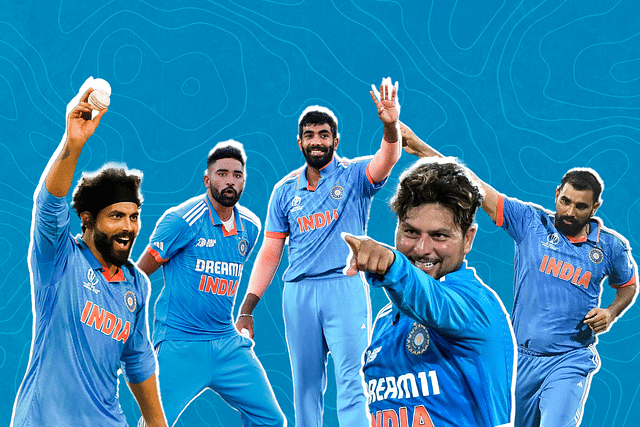Sports
Is This The Best Indian Bowling Attack Of All Time?
K Balakumar
Nov 06, 2023, 07:34 PM | Updated 07:34 PM IST
Save & read from anywhere!
Bookmark stories for easy access on any device or the Swarajya app.

On Sunday (5 November), at the cavernous Eden Gardens, Virat Kohli gave himself a nice present on his thirty-fifth birthday, in the form of his forty-ninth one-day-international (ODI) century, one that equalled him with his hero Sachin Tendulkar.
The Mumbai legend had struck his forty-ninth century in his 451st ODI inning, while the Delhi star reached the coveted milestone in just his 277th.
Tendulkar ended his stellar ODI career by averaging a century every 9.22 innings, while Kohli has been scoring a ton every 5.65 innings. This is the closest to "Bradmanesque" we have at the moment in international cricket.
In the 2023 world cup, this was Kohli's second century (101*), his first (103*) having come against Bangladesh at Pune.
Kohli, who had gone off the boil a bit previously, has come back this year with old vigour in ODIs, a format that we can now say he has, more or less, solved.
With five centuries in the year, he has scored more than 1,000 runs at an impressive average of 72.18 and a strike rate of 99.82.
Notably, this is the eighth time that Kohli has scored over 1,000 runs in a calendar year in ODIs. Needless to say, the previous record was held by Tendulkar, who had managed this feat seven times.
It was indeed Kohli's epoch-making moment at Eden Gardens. But, even on such an occasion, I was more charged up to watch the Indian fast bowlers — the effervescent trio of Jasprit Bumrah, Mohammed Siraj, and Mohammad Shami — unleash.
This is not to mean any disrespect to Kohli. In any case, his centuries have an air of inexorability to them. They are like a mother's meal that you can be sure of and return to anytime.
But what Bumrah, Siraj, and Shami are dishing out has been a real feast, one that you want to partake in as long as it lasts.
Ever This Exciting?
Coming from a land that is besotted with batting and batting records, we used to hold off on our loo break when Tendulkar was at the crease.
We stood transfixed when M S Dhoni and Kohli built those partnerships where they ran the opposition ragged with their fleet-footed running between the wickets.
But seldom have we seen a bowling attack that doesn't let you take your eyes off the screen when in action. Every ball seems to arrive with an ominous precision or sly cunning.
Already some remarkable hall-of-famers — those that would forever be etched in our mental YouTube, where no organisation can strike them down for copyright violation — have been conjured up by Indian pacers in this tournament.
The two deliveries of Bumrah to Muhammad Rizwan and Shadab Khan at Ahmedabad verily belonged to a poker table. For, a poker player has to think strategically to keep the opponents off balance and also prevent predictability from seeping into his own play. That is what Bumrah did in that middle section of Pakistan's batting innings.
Then there was Shami at Lucknow against England, whose batters know a thing or two about playing seam and swing. But Ben stokes, on that raucous night of celebration in the stands, was found clueless against Shami's furiously jagging deliveries.
The delivery that eventually took him out seamed off the pitch so sharply that it looked like a throw from extra-cover. Stokes looked totally out of sorts, more like a novice than the certified limited-overs great that he is, in those 10 deliveries he faced.
But no honour is lost in losing your wicket to a delivery that would not look out of place even at the Louvre.
What of Siraj?
He leaked runs in the initial parts of the tournament, but right now he is in rhythm and his deliveries ask questions of the batsmen more tougher than on the JEE paper.
The way he prised out Kusal Mendis — probably one of the two Sri Lankan batsmen in any form in this tournament, Sadeera Samarawickrama being the other — with a ball that moved into the right-hander in the air and moved away a wee bit after pitching.
This was a delivery that belongs to the cupboard of the late Bishan Singh Bedi. Just that this came from Siraj, and at high pace. It was skill of the highest order.
Following close on the heels of these relentlessly brilliant fast bowlers are two left-arm spinners, Ravindra Jadeja and Kuldeep Yadav, with their big bag of tricks.
On Sunday at the Eden Gardens, on a slightly helpful pitch, Jadeja and Yadav made the South African batting line-up, which had previously lit up this tournament, look feckless.
No Match
Look at the opposition batting scorecards in the previous four games against India, when this bowling line-up was firmed up, thanks in the main to Hardik Pandya's injury.
Sri Lanka and South Africa have been smoked out for two-digit scores. Both teams did not manage in their entire innings what India scored in its powerplay overs. England was taken out for less than 130.
In their batting powerplay overs, here is what the opposition teams have come up with against India in these four matches: New Zealand — 35/2, England — 40/4, Sri Lanka — 14/6, and South Africa — 35/3.
This type of an attack is a throwback to the era of West Indian fast bowlers of the 1970s and 1980s, and the Aussie teams of the late 1990s and early 2000s.
In the history of Indian cricket, it is difficult to recall an entire attack functioning with so much potent coordination and decisive functionality.
In the 1970s, India had the famed spin quartet, which operated mostly as a trio or duo. They were exciting for sure, but as a team were never the force that the present lot seems now.
We have had great bowlers thereafter, too. Kapil Dev, Anil Kumble, Javagal Srinath, Zaheer Khan — but they were often one-man shows, solo workhorses that rose well above the others.
The spin attack of Kumble, Venkatapathy Raju, and Rajesh Chauhan spelt doom in the early 1990s, and the buzz they created in a series against England was sensational.
But that series will forever be asterisked by the fact that it was on spin-friendly pitches and against an English batting unit that showed less footwork at the crease than the exhibits at Tussauds.
Harbhajan Singh in that magical series against Australia in 2001 was sensational. But, again, that was individual brilliance rather than any sustained and skillful show by the bowling bulwark.
In the 1989 Test series against Pakistan in the neighbouring country, Dev and Manoj Prabhakar were mighty effective in tandem, and India drew the series against the odds.
But that was just a case of two fast bowlers exhibiting good form together; the attack otherwise just about made the cut.
In recent times, Ravichandran Ashwin and Jadeja, when bowling together, have been brilliant. But those performances have come in Tests where Indian spinners in Indian conditions are destined to dominate.
The Indian bowling unit in the 2003 world cup, in which India won seven games on the trot, was impressive and effective. It comprised Srinath, Kumble, Zaheer, Ashish Nehra, and Ajit Agarkar.
In the 1985 Benson & Hedges world championship of cricket, the Indian bowling unit, comprising Dev, Madan Lal, Roger Binny, Mohinder Amarnath, Ravi Shastri, and Laxman Sivaramakrishnan, was well-ordered and efficacious.
But that was in a small tournament with just five India matches. They took 49 out of the 50 possible wickets on offer.
Effective And Enjoyable
The cohesion combined with precision that the present lot have shown consistently is, however, a new feeling that Indian fans have never experienced before.
No wonder, it is a festival in the stands when India bowls these days.
The crowds roar in rambunctious fun as Jadeja ties them up in mazy knots.
They gasp in collective disbelief as one ball from Bumrah beats the bat, and also the wicket, by the proverbial hair's breadth and K L Rahul collects the ball over his shoulders, reflecting the pace and carry in the delivery.
They break out into triumphant laughter as yet another batsman plays over a Shami scud missile that unerringly takes out the base of the middle stump. It is pure exhilaration.
Usually, teams feed off the energy of the fans in the stadium. But here it seems to be the opposite. The electric energy of the Indian bowlers, and the team in general, has been galvanising the Indian fans.
And what we have on view is pure theatre, and the pulsation is large and palpable enough to be cut with a sword.
India has not conceded 300+ runs even once in the tournament where 400+ scores have not been uncommon. (For the record, Afghanistan, too, has not allowed the opposition to score 300+ runs so far.)
Look at the numbers notched up by the five Indian bowlers so far in this world cup: Bumrah in eight matches has 15 wickets at an average of 15.53 and an economy of 3.65; Shami's averages of 4, 16, 7, and 4.30 are scarcely believable; Jadeja is 8, 14, 17.35, and 3.76; and Kuldeep is 8, 12, 22.58, and 4.15. Only Siraj, at 8, 10, 31.70, and 5.23 seems expensive.
But the fact that all your main bowlers have scalped wickets in the double figures is proof enough of the fact that the attack is living up to the cliché of a well-oiled machine.
Of the eight innings, there have been five instances where at least one bowler has taken four or more wickets.
Bumrah and Siraj's strike rates are in the mid-20s, but Shami's is 9.7. The man is taking wickets every one and half overs.
Heck, India may or may not win the 2023 world cup. But this bowling attack has all our medals. Its skills have been priceless. It has been a sheer joy to watch them. Providing fun and joy is what sports is ultimately all about.
Save & read from anywhere!
Bookmark stories for easy access on any device or the Swarajya app.
Support Swarajya's 50 Ground Reports Project & Sponsor A Story
Every general election Swarajya does a 50 ground reports project.
Aimed only at serious readers and those who appreciate the nuances of political undercurrents, the project provides a sense of India's electoral landscape. As you know, these reports are produced after considerable investment of travel, time and effort on the ground.
This time too we've kicked off the project in style and have covered over 30 constituencies already. If you're someone who appreciates such work and have enjoyed our coverage please consider sponsoring a ground report for just Rs 2999 to Rs 19,999 - it goes a long way in helping us produce more quality reportage.
You can also back this project by becoming a subscriber for as little as Rs 999 - so do click on this links and choose a plan that suits you and back us.
Click below to contribute.





